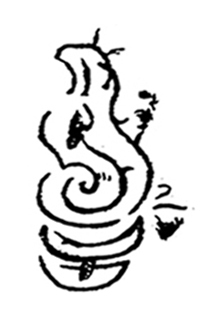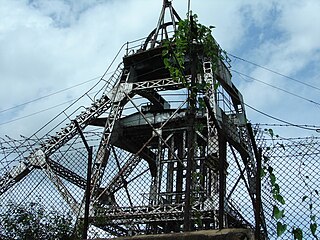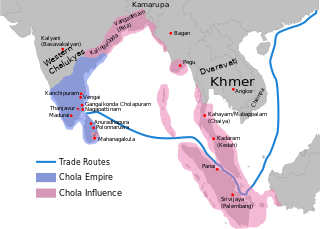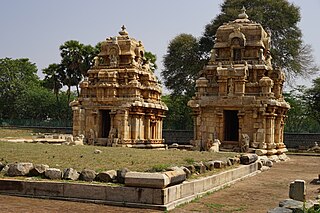
The Twin Temples at Keezhaiyur is a 9th-century temple complex built by the Paluvettaraiyar chieftains who were vassals of the Medieval Cholas at Keezhaiyur on the Trichy-Ariyalur highway. [1]

The Twin Temples at Keezhaiyur is a 9th-century temple complex built by the Paluvettaraiyar chieftains who were vassals of the Medieval Cholas at Keezhaiyur on the Trichy-Ariyalur highway. [1]
As the name suggests, the complex consists of two temples. The temple in the north is called Vadavaayil Sirikoil or Chozheecharam and the one in the south is called Thenvaaayil Sirikoil or Agatheeswaram . The temples were constructed by the Paluvettaraiyar chieftains Kumaran Maravan and Kumaran Kandan. [2]

Uttama Chola born Madurantaka ascended the Chola throne c. 970 CE succeeding Parantaka Chola II. According to Tiruvalangadu plates of Rajendra Chola, Madurantaka Uttama Chola's reign is placed after Aditya II. The latter may have been a co-regent of his father Sundara Chola and seems to have died before he could formally ascend the throne. Uttama was the cousin of Parantaka II and was the son of the illustrious Sembiyan Mahadevi and Gandaraditya.

Valluvanad was a minor independent kingdom in present-day central Kerala that held power from the early 12th century to the end of the 18th century. Prior to that, and since the late 10th century, Valluvanad existed as a district within the kingdom of the Chera Perumals of Mahodayapuram,. The disintegration of the Chera Perumal kingdom in c. 1124 CE led to the independence of the various ‘naadus’ within the kingdom, Valluvanad being one of them.
Kongu Nadu is a historical region comprising the western part of present Tamil Nadu. In the ancient Tamilakam, it was the seat of the Chera kings, bounded on the east by Tondai Nadu, on the south-east by Chola Nadu and on the south by Pandya Nadu regions.

Venad was a medieval kingdom lying between the Western Ghat mountains and the Arabian Sea on the south-western tip of India with its headquarters at the port city of Kollam/Quilon. It was one of the major principalities of Kerala, along with kingdoms of Kannur (Kolathunadu), Kozhikode and Kochi (Perumpadappu) in medieval and early modern period.

Kolar Gold Fields (K.G.F.) is a mining region in K.G.F. taluk (township), Kolar district, Karnataka, India. It is headquartered in Robertsonpet, where employees of Bharat Gold Mines Limited (BGML) and BEML Limited and their families live. K.G.F. is about 30 kilometres (19 mi) from Kolar, 29 kilometres (18 mi) from Kuppam, 100 kilometres (62 mi) from Bangalore, capital of Karnataka and 245 kilometers from Chennai, capital of Tamil Nadu. Over a century, the town has been known for gold mining. The mine closed on 28 February 2001 due to a fall in gold prices, despite gold still being present. One of India's first power-generation units was built in 1889 to support mining operations. The mine complex hosted some particle physics experiments between the 1960s and 1992.

The Chola dynasty was a Tamil thalassocratic empire of southern India, one of the longest-ruling dynasties in the world's history. The earliest datable references to the Chola are in inscriptions from the 3rd century BCE left by Ashoka, of the Maurya Empire. As one of the Three Crowned Kings of Tamilakam, along with the Chera and Pandya, the dynasty continued to govern over varying territory until the 13th century CE. Despite these ancient origins, the period when it is appropriate to speak of a "Chola Empire" only begins with the medieval Cholas in the mid-9th century CE.

The Cholas were a Tamil kingdom of the pre and post Sangam period. It was one of the three main kingdoms of the ancient Tamil country. Their early capitals were Urayur and Kaveripattinam. Along with Pandyas and Cheras, Chola history goes back to the period where written records were scarce.

The region of Tamil Nadu or Tamilakam, in the southeast of modern India, shows evidence of having had continuous human habitation from 15,000 BCE to 10,000 BCE. Throughout its history, spanning the early Upper Paleolithic age to modern times, this region has coexisted with various external cultures.

Dravidian architecture or the South Indian temple style is an architectural idiom in Hindu temple architecture that emerged in the southern part of the Indian subcontinent or South India and in Sri Lanka, reaching its final form by the sixteenth century. It is seen in Hindu temples, and the most distinctive difference from north Indian styles is the use of a shorter and more pyramidal tower over the garbhagriha or sanctuary called a vimana, where the north has taller towers, usually bending inwards as they rise, called shikharas. However, for modern visitors to larger temples the dominating feature is the high gopura or gatehouse at the edge of the compound; large temples have several, dwarfing the vimana; these are a much more recent development. There are numerous other distinct features.

Swetharanyeswarar Temple is a Hindu temple dedicated to the deity Shiva, located in Thiruvenkadu, a village in Mayiladuthurai district in the South Indian state of Tamil Nadu. Shiva is worshiped as Swetharanyeswarar, and is represented by the lingam. His consort Parvati is depicted as Brahmavidyambigai. The presiding deity is revered in the 7th century Tamil Saiva canonical work, the Tevaram, written by Tamil saint poets known as the Nayanars and classified as Paadal Petra Sthalam. It is significant to the Hindu sect of Saivism as one of the temples associated with the nine planet elements, the Navagraha Stalas, and specifically Budha.

Brihadishvara Temple, also called Rajarajesvaramor Peruvudaiyār Kōvil, is a Hindu temple dedicated to Shiva located in South bank of Kaveri river in Thanjavur, Tamil Nadu, India. It is one of the largest South Indian temples and an exemplary example of a fully realized Dravidian architecture. It is called as Dhakshina Meru. Built by Tamil king Raja Raja Chola I between 1003 and 1010 AD, the temple is a part of the UNESCO World Heritage Site known as the "Great Living Chola Temples", along with the Chola dynasty era Gangaikonda Cholapuram temple and Airavatesvara temple that are about 70 kilometres (43 mi) and 40 kilometres (25 mi) to its northeast respectively.

The Paluvettuvarayar were feudatories of the medieval Cholas. They ruled over the areas of Kila-Paluvur, Mela-Paluvur and Keezhaiyur in the Udaiyarpalayam taluk of the Tiruchirapalli district. They were responsible for a number of benefactions to the temples at this place and were known to have been related to the Cholas by marriage.

Ulagalandha Perumal Temple is a temple dedicated to Vishnu located in Kancheepuram, Tamil Nadu, India. Constructed in the Dravidian style of architecture, the temple is glorified in the Divya Prabandha, the early medieval Tamil canon of the Azhwar saints from the 6th through 9th centuries CE. It is one of the 108 Divyadesam dedicated to Vishnu, who is worshipped as Ulagalantha Perumal and his consort Lakshmi as Amudavalli. The temple is believed to have been built by Pallavas, with later contributions from Medieval Cholas, Vijayanagar kings and Madurai Nayaks.
Thillai Kali Temple is a Hindu Temple located on the outskirts of the town of Chidambaram, Cuddalore District Tamil Nadu in India. It was built by Chola King Kopperunjingan who ruled between 1229 and 1278.

Moovar Koil or "The Three temples" is a Hindu temple complex situated in the village of Kodumbalur, 36 kilometres from Pudukkottai in Tamil Nadu, India. These temples were constructed by the Chola feudatory and Irukkuvel chieftain Boothi Vikramakesari as per the inscription. Only two of the three temples have managed to survive. The place was ruled by Irukkuvel chieftains. Kodumbalur was also the site of a fierce battle between the Pandyas and the Pallavas.

Ulagalantha Perumal Temple or Trivikrama Temple is a Hindu temple dedicated to Vishnu located in Tirukkoyilur, Tamil Nadu, India. Constructed in the South Indian style of architecture, the temple is glorified in the Divya Prabandha, the early medieval Tamil canon of the Azhwar saints from the 6th–9th centuries AD. It is one of the 108 Divyadesam dedicated to Vishnu, who is worshipped as Ulagalantha Perumal and his consort Lakshmi as Poongothai. The temple is believed to have been built by the Medieval Cholas, with later contributions from Vijayanagar kings and Madurai Nayaks. The temple covers an area of 5 acres (20,000 m2) and has a temple tower that is the third tallest in Tamil Nadu, measuring 192 ft (59 m) in height.

Nearly 33,000 ancient temples, many at least 800 to 2000 years old, are found scattered all over Tamil Nadu. As per Tamil Nadu Hindu Endowments Board, there are 38615 Temples. Most of the largest Hindu Temples reside here. Studded with complex architecture, variety of sculptures, and rich inscriptions, the temples remain the very essence of the culture and heritage of Tamil land, with historical records dating back to at least 3,000 years.

Thiruvalla copper plates, also known as the Huzur Treasury Plates, are a collection of medieval temple committee resolutions found at the Sreevallabha Temple, Thiruvalla, Kerala. The collection of plates, engraved in old Malayalam language in Vattezhuthu with some Grantha characters, can be dated to 10th and 11th centuries AD.

Boothi Vikramakesari was a Velir Irukkuvel chieftain and a feudatory of the medieval Cholas. He is best remembered for building the Moovar Koil temple complex, a collection of "Three temples" in the village of Kodumbalur, 36 kilometres from Pudukkottai in Tamil Nadu, India. His family was related to the Cholas by marriage. His mother was a Chola princess while his daughter married Chola prince Arindama.

Sivalokanathar temple is a Hindu temple dedicated to the deity Shiva, located in Gramam, a village in Villupuram district in the South Indian state of Tamil Nadu. Shiva is worshiped as Sivalokanathar, and is represented by the lingam. His consort Parvati is depicted as Soundaranayagi. The presiding deity is revered in the 7th century Tamil Saiva canonical work, the Tevaram, written by Tamil saint poets known as the Nayanars and classified as Paadal Petra Sthalam.
| This article about Hindu place of worship in Tamil Nadu is a stub. You can help Wikipedia by expanding it. |